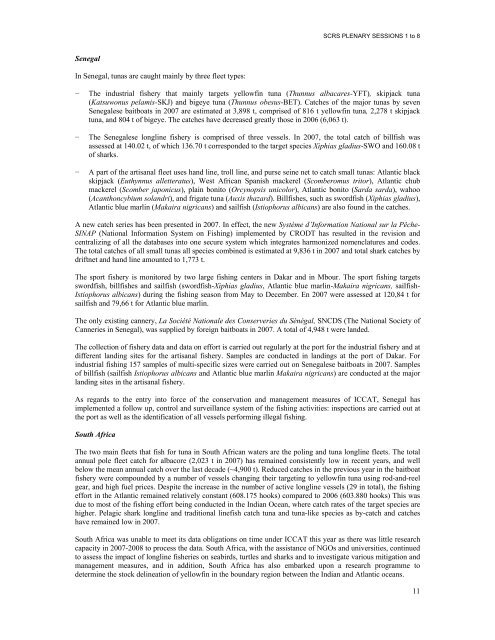REPORT OF THE STANDING COMMITTEE ON RESEARCH ... - Iccat
REPORT OF THE STANDING COMMITTEE ON RESEARCH ... - Iccat
REPORT OF THE STANDING COMMITTEE ON RESEARCH ... - Iccat
Create successful ePaper yourself
Turn your PDF publications into a flip-book with our unique Google optimized e-Paper software.
SCRS PLENARY SESSI<strong>ON</strong>S 1 to 8SenegalIn Senegal, tunas are caught mainly by three fleet types:− The industrial fishery that mainly targets yellowfin tuna (Thunnus albacares-YFT), skipjack tuna(Katsuwonus pelamis-SKJ) and bigeye tuna (Thunnus obesus-BET). Catches of the major tunas by sevenSenegalese baitboats in 2007 are estimated at 3,898 t, comprised of 816 t yellowfin tuna, 2,278 t skipjacktuna, and 804 t of bigeye. The catches have decreased greatly those in 2006 (6,063 t).−−The Senegalese longline fishery is comprised of three vessels. In 2007, the total catch of billfish wasassessed at 140.02 t, of which 136.70 t corresponded to the target species Xiphias gladius-SWO and 160.08 tof sharks.A part of the artisanal fleet uses hand line, troll line, and purse seine net to catch small tunas: Atlantic blackskipjack (Euthynnus alletteratus), West African Spanish mackerel (Scomberomus tritor), Atlantic chubmackerel (Scomber japonicus), plain bonito (Orcynopsis unicolor), Atlantic bonito (Sarda sarda), wahoo(Acanthoncybium solandri), and frigate tuna (Auxis thazard). Billfishes, such as swordfish (Xiphias gladius),Atlantic blue marlin (Makaira nigricans) and sailfish (Istiophorus albicans) are also found in the catches.A new catch series has been presented in 2007. In effect, the new Système d’Information National sur la Pêche-SINAP (National Information System on Fishing) implemented by CRODT has resulted in the revision andcentralizing of all the databases into one secure system which integrates harmonized nomenclatures and codes.The total catches of all small tunas all species combined is estimated at 9,836 t in 2007 and total shark catches bydriftnet and hand line amounted to 1,773 t.The sport fishery is monitored by two large fishing centers in Dakar and in Mbour. The sport fishing targetsswordfish, billfishes and sailfish (swordfish-Xiphias gladius, Atlantic blue marlin-Makaira nigricans, sailfish-Istiophorus albicans) during the fishing season from May to December. En 2007 were assessed at 120,84 t forsailfish and 79,66 t for Atlantic blue marlin.The only existing cannery, La Société Nationale des Conserveries du Sénégal, SNCDS (The National Society ofCanneries in Senegal), was supplied by foreign baitboats in 2007. A total of 4,948 t were landed.The collection of fishery data and data on effort is carried out regularly at the port for the industrial fishery and atdifferent landing sites for the artisanal fishery. Samples are conducted in landings at the port of Dakar. Forindustrial fishing 157 samples of multi-specific sizes were carried out on Senegalese baitboats in 2007. Samplesof billfish (sailfish Istiophorus albicans and Atlantic blue marlin Makaira nigricans) are conducted at the majorlanding sites in the artisanal fishery.As regards to the entry into force of the conservation and management measures of ICCAT, Senegal hasimplemented a follow up, control and surveillance system of the fishing activities: inspections are carried out atthe port as well as the identification of all vessels performing illegal fishing.South AfricaThe two main fleets that fish for tuna in South African waters are the poling and tuna longline fleets. The totalannual pole fleet catch for albacore (2,023 t in 2007) has remained consistently low in recent years, and wellbelow the mean annual catch over the last decade (~4,900 t). Reduced catches in the previous year in the baitboatfishery were compounded by a number of vessels changing their targeting to yellowfin tuna using rod-and-reelgear, and high fuel prices. Despite the increase in the number of active longline vessels (29 in total), the fishingeffort in the Atlantic remained relatively constant (608.175 hooks) compared to 2006 (603.880 hooks) This wasdue to most of the fishing effort being conducted in the Indian Ocean, where catch rates of the target species arehigher. Pelagic shark longline and traditional linefish catch tuna and tuna-like species as by-catch and catcheshave remained low in 2007.South Africa was unable to meet its data obligations on time under ICCAT this year as there was little researchcapacity in 2007-2008 to process the data. South Africa, with the assistance of NGOs and universities, continuedto assess the impact of longline fisheries on seabirds, turtles and sharks and to investigate various mitigation andmanagement measures, and in addition, South Africa has also embarked upon a research programme todetermine the stock delineation of yellowfin in the boundary region between the Indian and Atlantic oceans.11
















